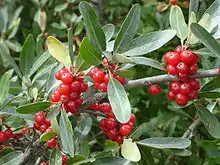Shepherdia
Shepherdia, commonly called buffaloberry[1] or bullberry, is a genus of small shrubs in the Elaeagnaceae family. The plants are native to northern and western North America.[2] They are non-legume nitrogen fixers.
| Shepherdia | |
|---|---|
 | |
| Shepherdia argentea | |
| Scientific classification | |
| Kingdom: | Plantae |
| Clade: | Tracheophytes |
| Clade: | Angiosperms |
| Clade: | Eudicots |
| Clade: | Rosids |
| Order: | Rosales |
| Family: | Elaeagnaceae |
| Genus: | Shepherdia Nutt. |
| Species | |
|
See text | |
| Synonyms | |
| |
Species
The genus has three species:
| Image | Scientific name | Common name | Distribution |
|---|---|---|---|
 | Shepherdia argentea | silver buffaloberry[3] | central and western North America, from the Prairie Provinces of Canada (Alberta, Saskatchewan, Manitoba) southwards in the United States as far as Ventura County in California, as well as northern Arizona, and northwestern New Mexico. |
 | Shepherdia canadensis | Canada buffaloberry | all of Canada, except in Prince Edward Island, and in the western and northern United States, including Alaska and Idaho |
 | Shepherdia rotundifolia | roundleaf buffaloberry | endemic to southern Utah and northern Arizona |
Fruit
The berry is recognizable by being a dark shade of red, with little white dots on them. They are rough to the touch, and are found on both trees and shrubs.
Wildlife
The plants have rather bitter-tasting berries. The fruit are often eaten by bears, which by legend, prefer the berries to maintain fat stores during hibernation.[4]
Buffaloberries are used as food plants by the larvae of some Lepidoptera species, including Ectropis crepuscularia (recorded from S. canadensis) and Coleophora elaeagnisella.
References
- "Shepherdia". Natural Resources Conservation Service PLANTS Database. USDA. Retrieved 11 November 2015.
- "Shepherdia Nutt". USDA PLANTS.
- "Silver buffaloberry" (PDF).
- Elias, Professor, Thomas S. (1983). Edible Wild Plants A North American Field Guide (Digitized online by Google books). Peter A. Dykeman. Cengage Learning. pp. 9–28, 258. ISBN 0-442-22254-8. Retrieved 2009-01-25.
This article is issued from Wikipedia. The text is licensed under Creative Commons - Attribution - Sharealike. Additional terms may apply for the media files.
